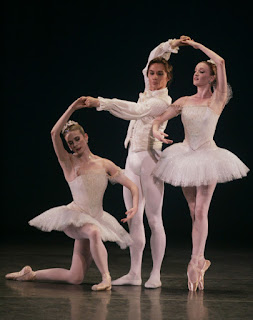Dance Review: Dance in Various Forms
American Ballet Theater
David Koch Theater, Lincoln Center, Manhattan
October 20, 2018
Humans
Directed by Yaron Lifschitz
Circa Contemporary Circus, Brisbane AUS
Brooklyn Academy of Music
October 4, 2018
I saw two very different but entertaining dance evenings in
October. The grand American Ballet Theater is known for its full length romantic
ballets (like Swan Lake) on the huge stage of the Metropolitan Opera. But in
the fall they do an annual series of collections of shorter works in the more
viewer-friendly confines of the Koch Theater, normally the purview of the New
York City Ballet. This year they intruded on the normal NYCB turf of George
Balanchine, performing a wonderful version of his Symphonie Concertante (1945), set to the wonderful concerto for
violin and viola by Mozart. The dance oozed classicism, with typical Balanchine
tutu-ed ballerinas arrayed in geometrical forms, perfectly shifting to changes
in the music. The two instrumental voices (well-played by orchestra members
Gora Schmidt and Shmuel Katz) were echoed on stage by two ballerinas (Stella
Abrera, Gilliam Murphy), partnered at times by the statuesque Alexandre
Hammoudi. Balanchine plays with every combination of two and three you can imagine.
The buoyant first movement involved multiple solo and duo interactions between
the women, sometimes explicitly reflecting the ornaments and passages of the
string players. The striking second movement was largely danced by the two
women each with one hand always in contact with Mr. Hammoudi, often required
contortionist moves that needed to look like ballet, not Cirque du Soleil (see
below).
The final movement featured intricate solo and ensemble work with much
interaction with the superb women of the ABT corps de ballet. This was a typically
bracing and superb partnering of music and dance by Mr. Balanchine. Ms. Abrera
was particularly stylish with her crisp classical lines.
Next up was a new ballet Garden
Blue by young choeographer Jessica Lang (the ABT is featuring female
choreographers this season). Set to an abbreviated version of the Dvorak E minor
“Dumky” Trio, it featured paired man-woman couples, each in a brightly monocolored
unitard (all orange vs. all purple, etc.) flitting about abstract huge wooden
flowers and leaves. There were intermittent interjections by a solo woman
dancer in a white/green contrasting costume (Christine Shevchenko, who needed
to have more fun)—was she a grasshopper?. I liked the set and the colors better
than the dance, which never really created its own style or really interfaced with
the music, although Dvorak is always a good choice if you want to portray sunny
colorful garden music. The trio in the pit did not project as well as it might
have on stage, but that would have disrupted the flowers and bees.
The night’s final piece was Fancy
Free (1944), featuring Jerome Robbins’ choreographed WW2 sailors on leave
picking up two girls (or at least trying to) in NYC. It’s sort of a prelude to
the later, more fleshed-out ballet from the musical On the Town (1960). Both Robbins ballets feature jazzy scores,
leaping sailors, and macho bravado (best communicated here by Arron Scott,
terrifically extrovert New York-y). Unlike On
the Town, none of the guys succeeds in “getting” one of the two girls (outstanding
work here by the brassy and flirty Luciana Peris and Isabella Boylston, the
latter a long way from her usually cool Giselles and Swans) and there is less
innuendo of gay attraction here than in the later work (it is 1944 after all). It
featured a dance-off with the winners to get the girls (didn’t work, alas) and
lots of opportunity for the women to reject the oversexed guys. It was fun seeing
this work in the city of its inspiration, and seeing the collaboration of two
of the four men (the other two were lyricist Stephen Sondheim and writer Arthur
Laurents) who, allegedly after a double date, came up with West Side Story, set just two blocks away from the theater.
On the face of it, the vastly entertaining Humans by the Australian Circa Circus Ensemble is far from ballet.
Most of the audience, I think, came to Brooklyn to see a Cirque du Soleil
acrobatics show, with similar death-defying lifts, pyramids, and contortions. They
got that, but there is a more refined choreographic spirit at play here, and
the hour-long performance came across as an intriguing mix of modern dance,
acrobatics, rhythmic gymnastics (albeit without real synchrony) and, yes,
circus showmanship. The six men and three women paired in almost every
combination and sense of the word. They nicely mixed showy circus-gasping type
lifts with introverted solo dances, sexual writhing on the stage, and humor. I
enjoyed a bit where one performer’s inability to lick his elbow (a frustrated
acrobat indeed) turned into a sort of group orgy where each tried to lick his
or another’s elbow in highly individual ways. Exhibitionism was never far from
the surface, and the sexuality was more earthy than the costumed eroticism of
Cirque du Soleil. Here, women were dragged around the stage by their
hair; men grinded against one another.
The dancers entered the stage in drab millennial street
clothes, some coming from the audience before the show started, and stripped
one at a time as we watched, leaving their street clothes on the stage, leaving
themselves in flesh-colored shorts or clingy leotards. The show title Humans ended up being very apt; despite
their super-human feats, this performance was by real people with varied
bodies, untrimmed facial and body hair untrimmed, and genuine Australian exhibitionism.



Comments
Post a Comment